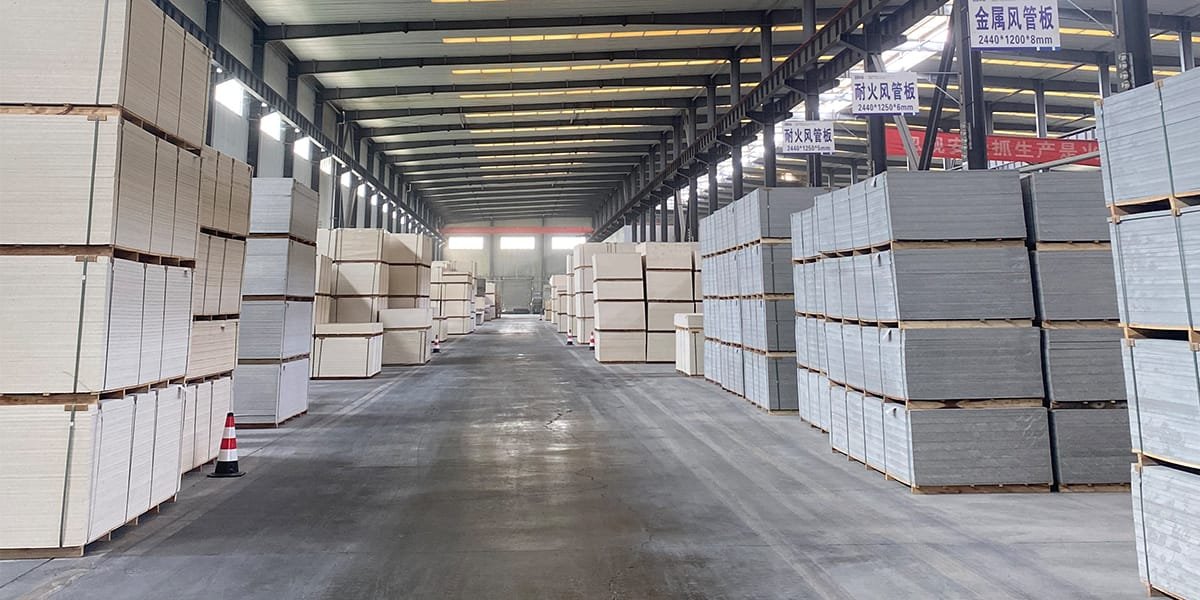
24 Jun A Comprehensive Guide to Sheathing Board Options
Table of Contents
Sheathing board options are important in building strong and safe structures. They help with insulation and protect buildings from damage. Buildings use 40% of U.S. energy, but insulated boards can save energy. The market for plywood and OSB sheathing was worth $55 billion in 2023. It may grow to $82 billion by 2032, showing their value. Top companies now make sheathing board options that resist water and fire. Knowing how these boards work can help you pick the best ones for your projects.
Key Takeaways
- Pick the right sheathing board to make your building stronger, safer, and more energy-efficient.
- OSB and plywood are affordable choices for homes. They are strong and useful for many purposes.
- In fire-risk areas, use gypsum or magnesium oxide boards for safety and to follow rules.
- For wet places, fiber cement and glass mat boards resist water and last longer.
- Use energy-saving materials like rigid foam boards or Structural Insulated Panels to cut heating and cooling costs.
Types of Exterior Wall Sheathing
Oriented Strand Board (OSB)
Oriented Strand Board (OSB) is a common choice for exterior walls. It is made by pressing wood strands with glue to create strong panels. OSB sheathing is used in walls, floors, and roofs because it resists moisture and stays stable over time.
Tip: OSB is great for projects needing affordable and sturdy sheathing.
The OSB market has grown quickly, especially the OSB/1 type, which was popular in 2023. OSB is used in many areas, like floors, walls, and roofs. Floors are expected to grow faster due to more cities and new buildings. Higher grades like OSB/3 are now preferred as rules require better materials.
Key Benefits of OSB:
- Durability: OSB does not warp or crack easily, lasting a long time.
- Cost Efficiency: OSB costs less than plywood but works just as well.
- Versatility: OSB can be used in homes and businesses for sheathing.
Plywood
Plywood sheathing is another popular option for exterior walls. It is made by gluing thin wood layers together, forming strong and flexible panels. Plywood can handle heavy loads and does not split easily.
Why Choose Plywood Sheathing?
- Strength: Plywood supports walls well, even when carrying heavy weight.
- Moisture Resistance: Treated plywood avoids water damage, lasting longer in wet places.
- Eco-Friendly: Many companies use wood from sustainable sources, making plywood greener.
Plywood sheathing is chosen for projects needing strength and flexibility. It works in homes and businesses, performing well in different weather conditions.
Foam Board Insulation
Foam board sheathing is great for saving energy in buildings. It keeps heat inside and stops moisture problems like mold. Foam boards have R-values between R-3.6 and R-8 per inch, showing their insulation power.
Note: Foam board insulation improves energy savings and strengthens your building.
Key Properties of Foam Board Insulation:
Property | Description |
|---|---|
Thermal Bridging Reduction | Foam board lowers thermal bridging, improving energy efficiency. |
R-Value | Polyiso foam has one of the best R-values per inch among rigid insulation. |
Foam board sheathing blocks air leaks, cutting heat loss by up to 40%. It keeps its R-value for years, helping save energy long-term.
Benefits of Foam Board Insulation:
Lightweight and simple to install, saving on labor costs.
Works well in homes and businesses for many uses.
Foam board insulation is ideal for projects focused on saving energy and stopping moisture. It’s a smart choice for eco-friendly and high-performance buildings.
Gypsum Sheathing
Gypsum sheathing is often used for outside walls. It resists fire and adds strength to buildings. It has a gypsum center with paper on both sides. This makes it light but strong. It’s common in homes and businesses where fire safety matters.
Tip: Type X gypsum sheathing is made for better fire resistance. It’s great for places with strict building rules.
Key Features of Gypsum Sheathing:
Fire Resistance: Type X gypsum meets ASTM Standard C 1396. It passes fire tests like ASTM E 119, helping buildings stay safe and strong.
Moisture Resistance: Treated gypsum handles moisture better than regular drywall but isn’t fully waterproof.
Ease of Installation: Its light weight makes it simple to carry and install, saving time during building.
Gypsum sheathing is good for areas with fire risks. It also creates a smooth base for outside finishes, making buildings look better.
Magnesium Oxide Board
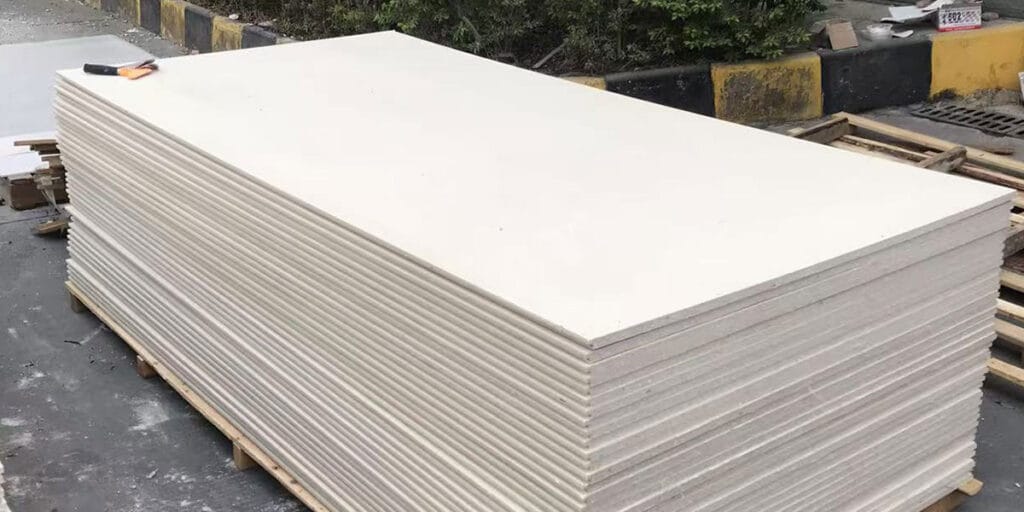
Magnesium oxide (MgO) board is a strong option for sheathing. It’s made from magnesium oxide mixed with other materials. It works well in tough conditions and is very versatile.
Why Choose Magnesium Oxide Board?
- Moisture Resistance: MgO boards don’t soak up water. They stop mold and stay strong in wet places.
- Durability: MgO boards don’t scratch or dent easily. They’re great for busy areas.
- Fire Resistance: MgO boards handle fire well, making them safe for risky areas.
Note: MgO boards are great for bathrooms and basements. These places often ruin other materials.
Comparative Advantages:
- Drywall gets weak and rots when wet, but MgO boards stay strong.
- Plywood can grow mold, but MgO boards resist it.
- MgO boards stay sturdy in humid places, making them reliable for outside walls.
Magnesium oxide board is tough and flexible. It’s a smart pick for wet or fire-risk areas needing strong sheathing.
Fiber Cement Board
Fiber cement sheathing is made from cement, sand, and fibers. It’s strong and lasts a long time. It’s great for outside walls in bad weather. You’ll see it used in homes and businesses.
Benefits of Fiber Cement Sheathing:
- Weather Resistance: Fiber cement handles heat, rain, and wind without breaking down.
- Fire Resistance: Its cement mix doesn’t burn, making it safer in fires.
- Longevity: Fiber cement lasts for years with little upkeep, saving money.
Tip: Fiber cement sheathing works well in coastal areas. Salt and moisture can harm other materials, but not this one.
Applications:
Fiber cement sheathing is good for siding and outside walls. It’s a solid base for paint or stucco, giving a clean look. It’s strong enough for busy areas and bad weather.
Fiber cement sheathing is tough, fireproof, and weather-resistant. It’s a dependable choice for long-lasting wall sheathing.
Structural Insulated Panels (SIPs)
Structural Insulated Panels (SIPs) are a modern way to build energy-saving and strong buildings. These panels have foam in the middle, with two layers of sheathing, often made of oriented strand board (OSB). SIPs combine insulation and support, making them a flexible choice for outside walls.
Why Pick SIPs?
- Energy Efficiency: SIPs keep heat in or out, cutting energy bills. The foam core stops heat from escaping, keeping rooms comfy.
- Strength and Durability: SIPs are strong, holding heavy loads without bending.
- Ease of Installation: Pre-made panels are quick to set up, saving time and money
Did You Know? SIPs can lower energy use by half compared to regular building methods.
Key Benefits of SIPs:
Feature | Details |
|---|---|
Market Growth | More people want energy-saving buildings, boosting SIPs’ popularity. |
Energy Standards | Building rules now favor eco-friendly materials like SIPs. |
Thermal Performance | SIPs insulate well, cutting energy use and making homes cozier. |
SIPs are perfect for projects needing energy savings and strong walls. Whether for homes or businesses, these panels are a smart and green choice.
Glass Mat Sheathing
Glass mat sheathing is tough and keeps water out, making it great for outside walls. It has a gypsum center covered with fiberglass mats, giving it strength and protection. This type works well for both structural and non-structural sheathing needs.
Why Use Glass Mat Sheathing?
- Moisture Resistance: Fiberglass mats stop water, preventing mold and mildew.
- Fire Safety: Glass mat sheathing doesn’t burn, making it safer in fires.
- Dimensional Stability: It stays strong even with temperature or humidity changes.
Tip: Glass mat sheathing has a 12-month exposure warranty, so it’s good for areas with unpredictable weather.
Performance Highlights:
Advantage | Explanation |
|---|---|
Moisture Resistance | Keeps water and mold away, lasting longer in wet places. |
Fire Resistance | Slows fire spread, improving safety in risky areas. |
Stability | Stays sturdy in different weather conditions. |
Glass mat sheathing is a reliable choice for outside walls. Its water and fire resistance make it great for apartments, offices, and homes.
Cement Board
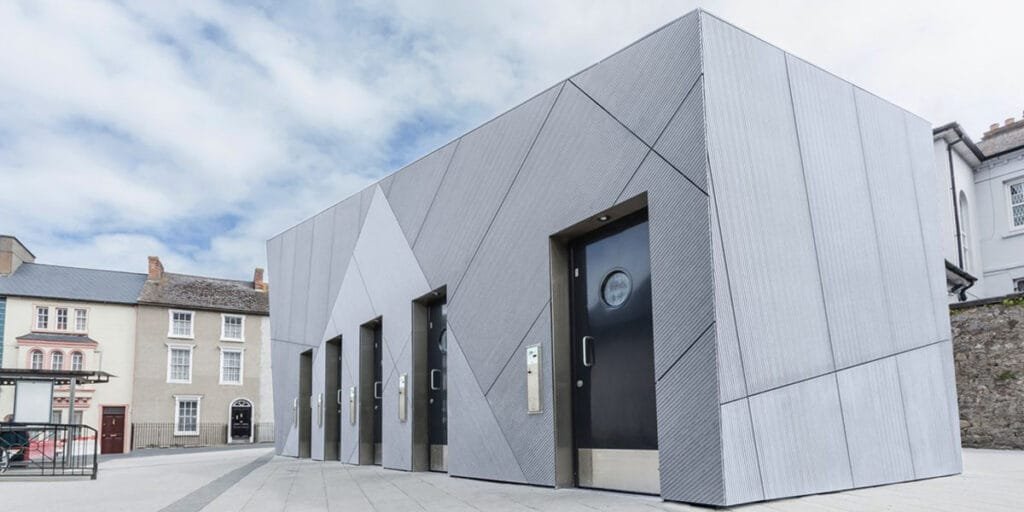
Cement board is a strong and long-lasting material made from cement and fibers. It’s often used for outside walls because it handles bad weather well. Cement board works best in places with lots of moisture or extreme temperatures.
Why Choose Cement Board?
- Weather Resistance: Cement board stands up to rain, wind, and heat without breaking down.
- Fire Resistance: It doesn’t burn, making it safer in fire-prone areas.
- Durability: Cement board doesn’t crack, bend, or rot, lasting a long time.
Note: Cement board is great for wet places like bathrooms or homes near the coast.
Uses for Cement Board
- Exterior Walls: A strong base for siding, stucco, or paint.
- Wet Areas: Perfect for bathrooms, kitchens, and other damp spaces.
- Commercial Buildings: Works well in busy or industrial areas.
Cement board is a solid choice for tough environments. Its strength and water resistance make it a favorite for homes and businesses alike.
ZIP System Sheathing
ZIP System Sheathing is a new type of sheathing. It combines strength and weather protection in one product. This makes building faster and easier. If you want to save time, cut energy costs, and stop moisture problems, this system could be a great choice.
What Makes ZIP System Sheathing Special?
This sheathing has a built-in water-resistant layer. Unlike older methods needing separate layers, ZIP System does it all at once. This saves time and lowers labor costs during construction.
Tip: Choose ZIP System Sheathing to make building quicker and simpler.
Key Benefits of ZIP System Sheathing
The ZIP System has many advantages over older methods. Here’s how it compares:
Feature | ZIP System Sheathing | Older Methods |
|---|---|---|
Blocks air leaks, saving energy and money | Air leaks can raise energy bills | |
Durability | Strong wood with water protection | May not handle bad weather as well |
Installation Time | Combines steps, saving time and money | Takes longer and needs more work |
Moisture Management | Stops water and mold problems | Higher chance of mold and water damage |
This table shows how ZIP System Sheathing beats older methods in energy savings, strength, and moisture control.
Why Pick ZIP System Sheathing?
Energy Savings: It seals tightly, stopping drafts and cutting energy use.
Weather Protection: Its water barrier keeps rain and snow out, preventing mold.
Quick Installation: It combines steps, making construction faster and cheaper.
Did You Know? ZIP System Sheathing can speed up installation by 40%, making it popular with builders.
Where to Use ZIP System Sheathing
You can use ZIP System Sheathing for homes or businesses. It works well for walls and roofs, especially in tough weather. Its energy-saving features also make it great for eco-friendly buildings.
ZIP System Sheathing changes how we build. It saves time, improves energy use, and protects against weather. If you need a strong and smart sheathing option, this system is worth a look.
Key Factors to Think About When Picking an Exterior Sheathing Board
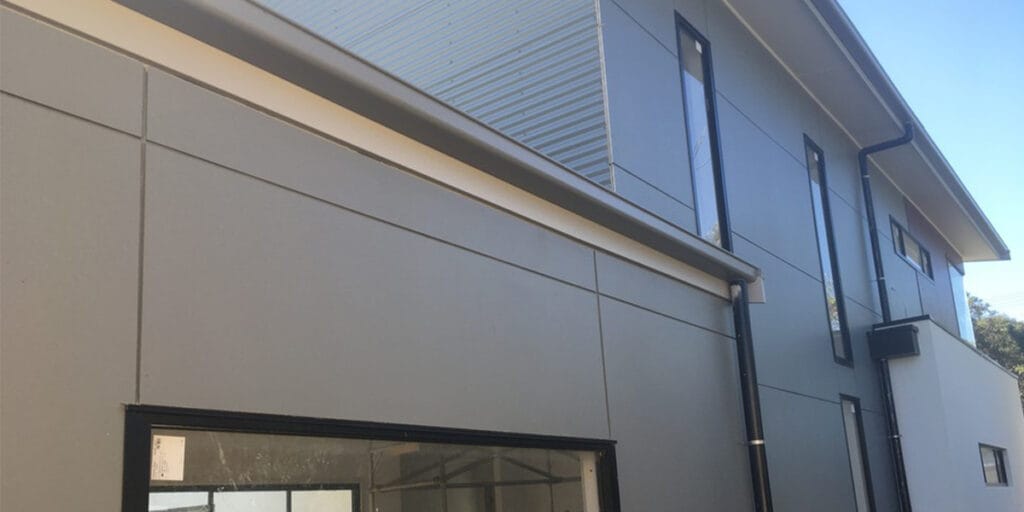
When choosing an exterior sheathing board, think about important factors. These include moisture resistance, fire resistance, and durability. Picking the right board helps your building stay safe and strong.
Moisture Resistance
Water can harm your sheathing and shorten its life. Boards that stay wet too long might warp, swell, or grow mold. This can weaken your building and lead to expensive repairs. Choosing a board that resists water keeps it strong for years.
Fiber cement and gypsum boards are great at stopping water. They work well in rainy places or areas with lots of moisture. Rigid foam boards also resist water and provide insulation. Plywood and OSB handle water okay but need extra sealing to last longer.
Tip: For wet areas, pick fiber cement or rigid foam boards for better protection.
Property | Fiber Cement | Gypsum Sheathing | Plywood | OSB | Rigid Foam |
|---|---|---|---|---|---|
Moisture Resistance | High | High | Moderate | Moderate | High |
Fire Resistance
Fire resistance is key in wildfire zones or where rules require fire-safe materials. Boards that resist fire slow flames, giving people more time to leave safely.
Gypsum boards are top-rated for fire safety. They pass tough tests like ASTM E119, which checks how well they hold up in fires. Fiber cement is also fireproof because it doesn’t burn. Plywood and OSB don’t resist fire well and aren’t good for risky areas.
- Gypsum boards meet ASTM E119 standards for fire safety.
- These tests check if materials stay strong and limit heat during fires.
- Fire ratings compare materials, but real-life results depend on building conditions.
Note: In fire-risk areas, use gypsum or fiber cement boards for the best safety.
Property | Fiber Cement | Gypsum Sheathing | Plywood | OSB | Rigid Foam |
|---|---|---|---|---|---|
Fire Resistance | High | High | Low | Low | Moderate |
Durability and Strength
Durability shows how well a board handles stress and weather over time. Strong boards resist cracking, bending, or breaking, keeping buildings sturdy.
Magnesium oxide (MgO) boards are very durable. They pass tests that mimic years of tough conditions. Fiber cement and gypsum boards are also strong and last a long time. Plywood and OSB are less durable, especially in humid places.
Tests like Modulus of Rupture (MOR) and Modulus of Elasticity (MOE) show how wood panels age. These tests simulate years of wear to predict how materials will perform.
- Studies test how panels hold up under different conditions, like moisture.
- MgO boards resist warping, swelling, and cracking in tough environments.
- Deterioration intensity (DI) helps predict how long wood panels will last.
Did You Know? Magnesium oxide boards are super durable, making them great for tough projects.
Property | Fiber Cement | Gypsum Sheathing | Plywood | OSB | Rigid Foam |
|---|---|---|---|---|---|
Durability | High | High | Moderate | Moderate | High |
By thinking about moisture, fire, and durability, you can pick the best sheathing board. These factors help keep your building safe, strong, and long-lasting.
Energy Efficiency and Insulation Properties
Saving energy helps lower costs and protect the environment. When picking a sheathing board, check how well it insulates and stops heat loss. Poor insulation lets heat escape, raising heating and cooling bills.
Buildings in the U.S. use about 40% of all energy and cause 38% of carbon dioxide emissions. Heat can escape through weak spots in insulation, called thermal bridging. This can lower insulation performance by 30% to 50%, wasting energy. Even small gaps can lead to big energy losses.
Rigid foam boards, like polyisocyanurate (Polyiso), are great at stopping thermal bridging. These boards have high R-values, which show how well they resist heat flow. They help keep rooms comfortable and cut energy bills. Structural Insulated Panels (SIPs) also insulate well, with foam cores and strong outer layers.
Tip: Pick boards with high R-values and low thermal bridging for better energy savings.
Sheathing Type | R-Value per Inch | Thermal Bridging Reduction | Best Use Cases |
|---|---|---|---|
Rigid Foam (Polyiso) | R-6 to R-8 | High | Energy-efficient homes |
Structural Insulated Panels | R-4 to R-6 | High | Eco-friendly and modern buildings |
Choosing the right sheathing board can improve energy use and lower your building’s carbon footprint.
Cost and Budget
Your budget matters when picking a sheathing board. Some materials cost more upfront but save money later because they last longer and work better.
For example, ZIP System Sheathing combines strength and water protection in one product. This saves time and labor costs during installation. Plywood with a separate water barrier may cost less at first but takes more time and effort to install.
Here’s a cost comparison of popular sheathing options:
Sheathing Option | Cost per Unit | WRB Cost per Square Foot | Total WRB Area | Total Cost Contribution |
|---|---|---|---|---|
ZIP System Sheathing | $20.15 | $0.66 | 2,434.66 sq ft | ~2% of overall budget |
1/2 inch 5 Ply CDX | $20.02 | $0.72 | 2,434.66 sq ft | ~2% of overall budget |
Tyvek (WRB only) | N/A | $0.66 | N/A | N/A |
Henry Blueskin Vp100 (WRB) | N/A | $0.72 | N/A | N/A |
Solitex Adhero (WRB) | N/A | $1.02 | N/A | N/A |
Note: ZIP System Sheathing costs more per unit but saves on labor and extra materials.
When planning, think about both upfront costs and long-term savings. Strong and energy-saving materials often give the best value over time.
Environmental Impact and Sustainability
Building with eco-friendly materials is more important than ever. Many sheathing boards now aim to reduce their environmental impact.
A lifecycle assessment looks at a product’s impact from start to finish. For example, cellulosic fiberboard (CFB) has two main stages. The “cradle-to-gate” stage includes getting raw materials, transport, and making the product. The “gate-to-grave” stage covers delivery, use, and disposal. Knowing these stages helps pick greener materials.
Lifecycle Stage | Description |
|---|---|
Cradle-to-Gate | Covers extraction of raw materials, transport, and manufacturing of cellulosic fiberboard (CFB). |
Gate-to-Grave | Includes transportation, installation, use, and disposal of CFB at the end of its life. |
Environmental Impacts | Identifies hotspots in lifecycle stages to help reduce environmental impacts in construction. |
Fiber cement and magnesium oxide boards are great for green projects. They often use recycled materials and make fewer emissions during production. Rigid foam boards also save energy, lowering a building’s carbon footprint.
Did You Know? Using sustainable sheathing materials can reduce environmental harm and meet green building standards.
By choosing eco-friendly materials, you can build structures that are strong, efficient, and better for the planet.
Easy Installation and Care
When picking a sheathing board, think about how simple it is to set up and take care of. Boards that are easy to install save time and effort. Low-maintenance boards also cut down on future costs and work, making your project smoother.
Quick Installation
Some boards are faster to install than others. Common choices like plywood and OSB are easy to find and use. They are light and come in standard sizes, making them popular with builders. You can cut and attach them using basic tools, which speeds up the job.
Tip: For fast projects, go with plywood or OSB boards.
Newer options like ZIP System Sheathing make installation even quicker. This board combines strength and water protection in one piece. It skips the need for extra weatherproof layers, saving a lot of time. Builders say ZIP System Sheathing can cut setup time by nearly 40%.
Structural Insulated Panels (SIPs) also help with quick installation. These panels are pre-made and ready to use, reducing the work needed on-site. They also include insulation, which saves even more time.
Long-Term Care
Taking care of your sheathing board is important for its lasting performance. Boards like insulated OSB resist water damage, so they need less upkeep. They don’t swell, warp, or grow mold, keeping your building in good shape for years. Plus, their energy efficiency can lower utility bills, making them a smart long-term choice.
Fiber cement and magnesium oxide boards are also low-maintenance. They resist fire, water, and pests, so you won’t need to fix them often. These boards stay strong even in tough conditions.
Did You Know? Fiber cement boards can last for decades with little care, making them a great choice for long-term projects.
However, plywood and OSB may need more attention in wet areas. Adding sealants or weatherproof layers can help them last longer. While they’re easy to install, plan for regular care to keep them in good condition.
Comparing Installation and Care
Here’s a simple chart comparing popular sheathing boards based on how easy they are to install and maintain:
Sheathing Type | Installation Ease | Maintenance Needs | Best Uses |
|---|---|---|---|
OSB | High | Moderate | Fast and budget-friendly projects |
Plywood | High | Moderate | General building needs |
ZIP System Sheathing | Very High | Low | Quick and energy-saving builds |
Structural Insulated Panels | High | Low | Green and modern buildings |
Fiber Cement | Moderate | Very Low | Durable and long-lasting projects |
Magnesium Oxide | Moderate | Very Low | Wet or fire-risk areas |
By choosing the right board, you can balance easy setup and low maintenance. Whether you need speed, strength, or savings, there’s a sheathing board that fits your needs.
Best Sheathing Board Options for Specific Applications
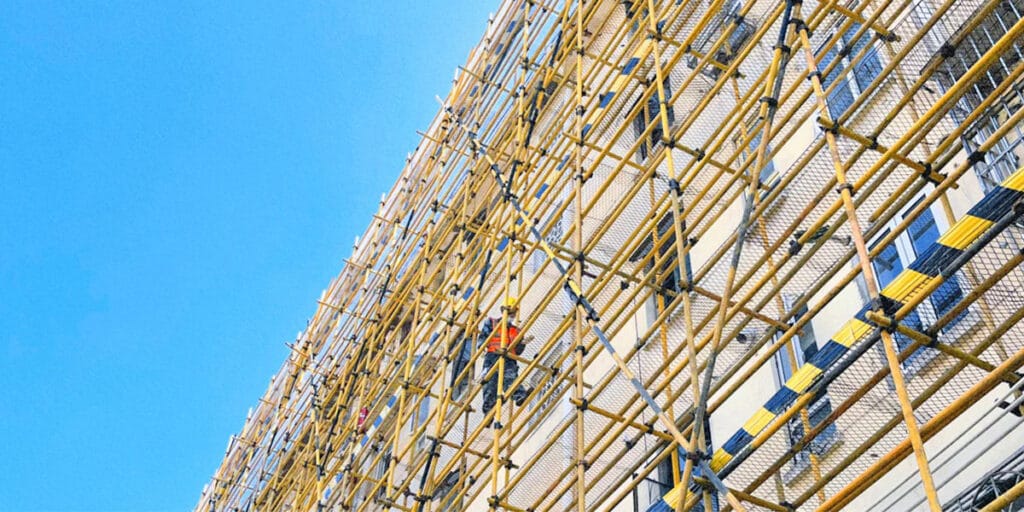
Residential Construction
For homes, you need boards that are affordable, strong, and energy-saving. OSB and plywood are great picks because they cost less and stay sturdy. OSB is especially good for walls, floors, and roofs. It performs well and saves money.
Projects like Heathwood Homes’ Country Lane show how Alleguard’s products save energy and cut costs. Studies on wall upgrades also show that low-density fiberglass boards and OSB improve insulation by filling air gaps. This makes them perfect for homeowners who want to save energy.
Tip: Pair OSB with rigid foam boards to block heat loss and save energy.
Commercial Buildings
For businesses, you need boards that meet fire safety, insulation, and strength rules. Gypsum sheathing and fiber cement boards are top choices. They resist fire, making them safe for busy buildings.
Rigid foam boards like Polyiso insulate well and stop heat loss. OSB and plywood are also used because they keep walls stable and strong. Tests show these materials stay steady in different conditions and meet certifications like UL GREENGUARD Gold for clean indoor air.
Feature | Details |
|---|---|
Warranty | |
Dimensional Stability | Stays strong in changing temperatures and humidity. |
Certification | Certified for low chemical emissions, improving air quality indoors. |
High-Moisture Environments
In wet areas, pick boards that fight water, mold, and mildew. Fiber cement boards and glass mat sheathing are great options. They have water-resistant cores and treatments to stop mold, keeping them strong for years.
These boards work well with finishes like wood, brick, or stucco. They’re easy to install and add fire safety. In noisy places, they also help reduce sound.
Did You Know? Glass mat sheathing resists water and comes with a 12-month warranty, making it perfect for areas with unpredictable weather.
Fire-Prone Areas
Picking the right sheathing board for fire-prone areas is crucial. Fire-resistant boards slow flames, giving people more time to leave safely. Gypsum sheathing and fiber cement boards are great because they don’t burn easily. Magnesium oxide (MgO) boards also work well in fires.
Tests show how different boards act during fires. These studies help make buildings safer:
Study Title | What It Tests |
|---|---|
Fire Effects on Steel Shear Walls – Phase 1 | Looks at fire impact on steel walls with different materials. |
Fire Effects on Steel Shear Walls – Phase 2 | Studies how fire and stress affect wall systems for safety. |
Tip: Use gypsum or MgO boards in places with strict fire rules. They meet ASTM standards and offer strong protection.
Choosing fire-resistant boards lowers risks and ensures your building follows safety codes.
Energy-Efficient Homes
Energy-efficient homes need materials that keep heat inside and save energy. Boards with high R-values help maintain indoor temperatures, cutting heating and cooling costs. Rigid foam boards, fiberboard, and Structural Insulated Panels (SIPs) are top picks for saving energy.
Here’s how some materials compare in insulation:
Material Type | R-value per inch |
|---|---|
Fiberboard | |
OSB | R-0.5 to 0.62 |
Plywood | R-0.5 to 0.62 |
Rigid foam boards, like polyisocyanurate, have the best R-values, making them perfect for eco-friendly homes. SIPs combine insulation and support, making construction easier and more efficient.
Did You Know? High-R-value boards can cut energy bills by 30%, making homes cheaper to heat and cool.
Pick boards that stop thermal bridging and keep their insulation over time. This keeps your home energy-efficient for years.
Eco-Friendly Construction Projects
Eco-friendly building uses materials that are better for the planet. Magnesium oxide (MgO) boards are a green choice for sheathing. They use less energy to make, release fewer chemicals, and can be recycled.
Feature | MgO Sheathing Boards | Traditional Materials |
|---|---|---|
Environmental Impact | Lower carbon emissions during production | Higher carbon emissions |
Recyclability | Fully recyclable | Often not recyclable |
Indoor Air Quality | Releases fewer harmful gases | May release harmful chemicals |
Durability | Longer lifespan | Shorter lifespan |
MgO boards are greener than plywood or drywall.
They reduce waste because they’re recyclable.
They improve air quality by releasing fewer harmful chemicals.
Tip: Use MgO boards for eco-friendly projects to lower your environmental impact and meet green goals.
Using sustainable boards helps build structures that last, save energy, and protect the environment.
Picking the right sheathing board keeps your building strong, safe, and energy-efficient. Each type has its own strengths. For instance, gypsum is great for fire safety, while foam boards save on energy bills. But some have downsides, like OSB swelling or plywood costing more.
Sheathing Type | Benefits | Drawbacks |
|---|---|---|
Gypsum | Fireproof, strong, no warping | Breaks easily if hit |
Foam Board | Saves energy, blocks heat loss | Needs extra steps to install |
Structural Fiberboard | Stable, insulates well, lowers energy costs | Can trap moisture if not installed right |
OSB | Cheap, easy to use | Swells and warps when wet |
Plywood | Strong, works for many designs | Costs more than OSB, may have weak spots |
Think about your project’s needs when choosing a board. For wet places, pick water-resistant ones like fiber cement. In fire-risk areas, go with gypsum or magnesium oxide boards. Always weigh cost against how well it performs over time to get the best value.
Tip: Match your building’s conditions and budget to the best sheathing board for your needs.
FAQ
What do exterior sheathing boards do?
Exterior sheathing boards make walls stronger and protect buildings. They help keep heat in, block moisture, and resist fire.
Which boards save the most energy?
Rigid foam boards and Structural Insulated Panels (SIPs) are great for saving energy. They stop heat loss and lower energy bills with high R-values.
Can OSB be used in wet places?
OSB can be used in wet areas if sealed well. But fiber cement or magnesium oxide boards handle water better and last longer.
Are fireproof boards expensive?
Fireproof boards like gypsum or fiber cement cost more at first. Over time, they save money by lowering fire risks and meeting safety rules.
How do I pick the best sheathing board?
Think about your project’s needs, like water or fire resistance and cost. Use water-resistant boards for wet areas and fireproof ones for fire-prone zones.
